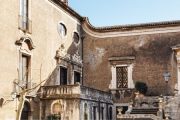While in Madrid we took advantage of our time there to explore. It is an elegant city, built on a grand scale, with many stately buildings, wide streets, water fountains, pedestrian areas, and huge parks. El Retiro, a 350-acre park in the middle of the city, is a popular recreation hub where people go to enjoy the beautiful open spaces and to relax. It has a small lake with boat rentals, wide tree-lined walkways, picnic sites, food kiosks, vendors, and a large rose garden where roses by the thousands were still in bloom.
Casa de Campo, on the west side of Madrid, is a colossal 4255-acre park, once a royal hunting estate. It is now one of the chosen habitats of an invasive species of bird- The Argentine parrot or parakeet. They were originally kept as pets, but declared illegal in 2011. When they were released or escaped from their cages, they adapted quickly to life on their own and took to the treetops in this park as well as other parts of the city where they have thrived, now reaching a population of more than 12,000. They build enormous 400-pound nests and compete aggressively with native birds for the food supply. Madrid is actively planning ways to cull their numbers. Little do these noisy, bright green parrots realize that their remarkable success at surviving and thriving is leading to their downfall. Their fate has been decided.
Madrid differs markedly from our Canadian large cities in some respects. There seems to be a total absence of shopping malls and strip shopping plazas. Fast-food outlets are vastly out-numbered by specialty restaurants with outdoor cafes where people flock to dine. There are plenty of choices on the wide, tree-lined streets. In Spain tipping is not customary, nor is it expected. The service is equally good as in Canada where we are expected to generously tip servers even for ordinary or inferior service. Upscale specialty boutique stores cater to customers rather than the large department stores common in Canada.
Traffic-wise the city seems to be leaps and bounds ahead of our big-city gridlocked traffic problems. A series of ring roads, built partially underground with long tunnels, assist in reducing traffic volume by diverting it from the urban centre of the city. Traffic in the city centre seemed to flow smoothly, with motorcycles a very popular option for many citizens. Public transportation and taxi services were readily available.
After a few days we boarded a high-speed train that took us southward over 500 km of the semi-arid Central Plateau, with a brief stay in Cordoba (the hottest city in Europe), before going on to Seville. The barren landscape through which we travelled did indeed look dry, but it is suitable in some areas for wheat and other cereal grains. There was an absence of forested areas, except for the tens of thousands of olive trees dotting the landscape, some scattered about on hillsides and others in groves with neat, straight rows on flat terrain. I learned later that only 40 per cent of Spain’s land is suitable for cultivation and only 10 per cent is excellent, as the soil is of poor quality. However, it manages to grow a wide variety of products.





Anonymous5 years ago
A vivid recounting! I enjoyed seeing what details stuck out for a first time visitor to Spain– the black paella, the many motorcycles, the cotton plantations and orange groves.
Jim Cameron5 years ago
Thanks for your impressions, very enjoyable.
Anonymous5 years ago
Well done very enjoyable reading
Anonymous5 years ago
very interesting I would love to go there